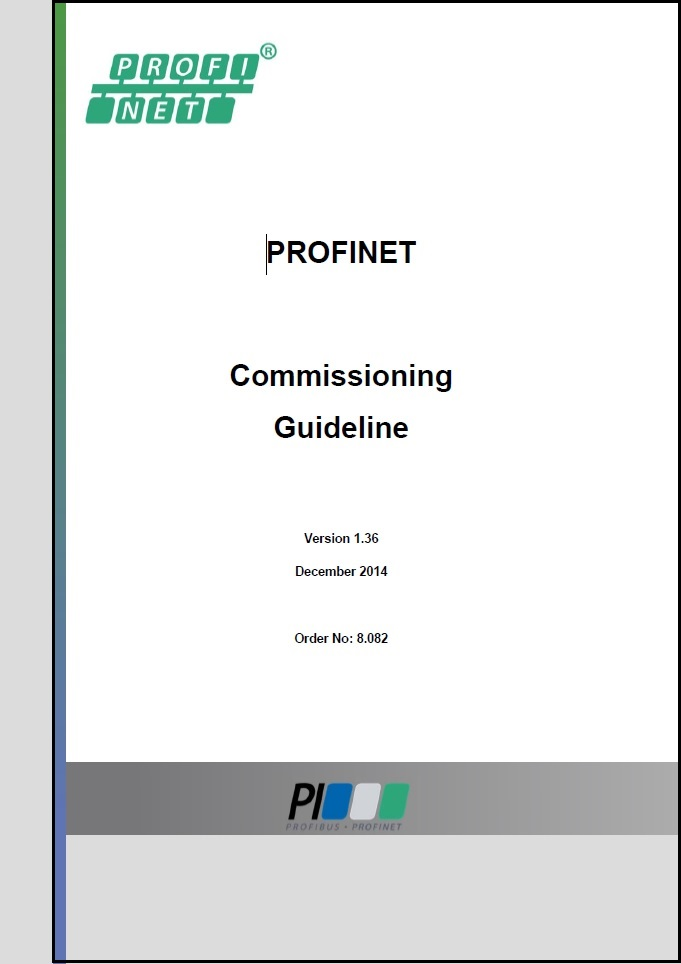Prior to starting your next PROFINET project, we recommend that you take a close look at PI’s PROFINET installation guidelines and planning tools. These guidelines were designed by engineers for engineers. They will help you with the design, installation, and commissioning of your PROFINET system. They contain tips and specifics that are often overlooked. There are three main guides a design guideline, an installation guideline, and a commissioning guideline. Also, a network load calculation tool helps plan network layout. Some commissioning and installation checklists are helpful for auditing the system.
PROFINET Design Guidelines
The design guideline would be the first place to look at as it focuses on the design and layout of your network, which in most cases is very important, and  planning of the network load. This includes how to organize the network topology depending on types of devices and also on the functions of them (for example RT or IRT motion traffic, wireless, power over Ethernet, etc.). Also, it discusses both real time and non real time (TCP/IP) network load and how to measure and plan based on these types of devices and max loading of the system.
planning of the network load. This includes how to organize the network topology depending on types of devices and also on the functions of them (for example RT or IRT motion traffic, wireless, power over Ethernet, etc.). Also, it discusses both real time and non real time (TCP/IP) network load and how to measure and plan based on these types of devices and max loading of the system.
Network Load Calculation Tool
The network load calculation tool helps you estimate the PROFINET portion of the communication load for the PLC / PC. This is beneficial to determine if the controller has the necessary bandwidth to meet the application requirements and number of devices/modules in the system. The result calculation can be compared with the controller specifications and adjustments made if necessary for the update time, number of devices / modules, or adding more controllers if needed, etc. controllers if needed, etc.
Additional Tools
The load calculation tool only shows the results of the PROFINET communication load at the controller, which is typically going to be quite smaller than the larger packets which typically come from other types of TCP/IP based devices like HMIs, vision systems, video cameras / streams, IP phones, or other protocols running on the PLC, etc. For planning involving these types of devices and multiple protocols, there are recommendations in the guidelines and planning tools from various vendors. These tools are more extensive and allow you to estimate the entire network load. For example, Siemens offers the Sinetplan tool (21 day trial version available), if you want to look at load from PROFINET and different types of devices and protocols (TCP/IP) as well in the same application. More topics covered in the design guideline include performance considerations, device parameters, media types, and others.

PROFINET Installation Guidelines
Next, the installation guide discusses proper installation of PROFINET cabling and assembly. This includes media types and connectors, as well as installing the cables, grounding and shielding, ESD, cable separation, bending radius, pulling (tensile) strength, and much more. When it comes to installation, these are probably the most important aspects because if you have a bad physical installation, you will have device issues!
PROFINET Commissioning Guidelines and checklists
Finally, once the network is designed and installed, the devices can be commissioned and acceptance tests performed on the actual communications. The commissioning guideline explains setting IP addresses, PROFINET device names and typical steps to configure real time IO devices with their GSD files, and proper network measurements. Among other topics, the guideline also adds some checklists to help with network audit and acceptance. For example, you can perform a network self-audit by using these checklists. In addition, professional network audits are available from various vendors if you wanted to go that route.
Summary
Links to all guidelines and tools here
Hopefully, we’ve convinced you of the importance of reading these guidelines They can really help your PROFINET projects and systems for long-term and stable use. Take a look and download them from PI’s website here. We also cover a lot of this information much more in-depth in our week-long Certified Network Engineer class. Join us and learn even more about networking, Ethernet, TCP/IP, UDP/IP, and PROFINET.
 Do you want to learn more about PROFINET?
Do you want to learn more about PROFINET?
The PROFI Interface Center has you covered with PROFINET Certified Network Engineer classes.
Our certification classes are intense, hands-on courses. You will learn how the underlying technology works from the application to the frame level. After passing both a practical and written exam, you become certified.
For more information, contact us or visit our website.